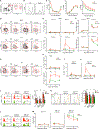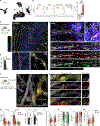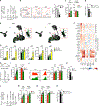CXCR6 positions cytotoxic T cells to receive critical survival signals in the tumor microenvironment
- PMID: 34343496
- PMCID: PMC8719451
- DOI: 10.1016/j.cell.2021.07.015
CXCR6 positions cytotoxic T cells to receive critical survival signals in the tumor microenvironment
Abstract
Cytotoxic T lymphocyte (CTL) responses against tumors are maintained by stem-like memory cells that self-renew but also give rise to effector-like cells. The latter gradually lose their anti-tumor activity and acquire an epigenetically fixed, hypofunctional state, leading to tumor tolerance. Here, we show that the conversion of stem-like into effector-like CTLs involves a major chemotactic reprogramming that includes the upregulation of chemokine receptor CXCR6. This receptor positions effector-like CTLs in a discrete perivascular niche of the tumor stroma that is densely occupied by CCR7+ dendritic cells (DCs) expressing the CXCR6 ligand CXCL16. CCR7+ DCs also express and trans-present the survival cytokine interleukin-15 (IL-15). CXCR6 expression and IL-15 trans-presentation are critical for the survival and local expansion of effector-like CTLs in the tumor microenvironment to maximize their anti-tumor activity before progressing to irreversible dysfunction. These observations reveal a cellular and molecular checkpoint that determines the magnitude and outcome of anti-tumor immune responses.
Keywords: CCR7(+) dendritic cells; CTL; CXCL16; CXCR6; IL-15; TCF-1; TCGA; multiphoton intravital microscopy; scRNA-seq; tumor microenvironment.
Copyright © 2021 Elsevier Inc. All rights reserved.
Conflict of interest statement
Declaration of interests S.K. has filed a patent application (PCT/EP2016/074644) related to the use of CXCR6-transduced T cells in tumor therapy. All other authors declare no competing interests.
Figures







Comment in
-
An intimate encounter: DC3s empower anti-tumor CTLs.Cancer Cell. 2021 Sep 13;39(9):1181-1183. doi: 10.1016/j.ccell.2021.08.010. Epub 2021 Aug 26. Cancer Cell. 2021. PMID: 34450048
References
-
- Ariotti S, Beltman JB, Borsje R, Hoekstra ME, Halford WP, Haanen JBAG, de Boer RJ, and Schumacher TNM (2015). Subtle CXCR3-Dependent Chemotaxis of CTLs within Infected Tissue Allows Efficient Target Localization. J. Immunol. 195, 5285–5295. - PubMed
Publication types
MeSH terms
Substances
Grants and funding
LinkOut - more resources
Full Text Sources
Other Literature Sources
Molecular Biology Databases

